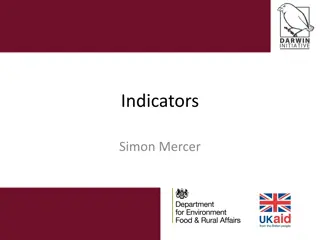Early Warning Indicators for Pine Island Glacier in West Antarctica
The study examines the tipping points and early warning indicators for Pine Island Glacier in West Antarctica, a key contributor to sea-level rise. Through an advanced ice flow model, the research reveals three tipping points and their associations with ocean warming. The findings also introduce early warning indicators for detecting critical slowing as a tipping point approaches. These indicators offer insights into the hysteresis behavior of the glacier, paving the way for potential early warning systems for other cryospheric systems.
Download Presentation

Please find below an Image/Link to download the presentation.
The content on the website is provided AS IS for your information and personal use only. It may not be sold, licensed, or shared on other websites without obtaining consent from the author.If you encounter any issues during the download, it is possible that the publisher has removed the file from their server.
You are allowed to download the files provided on this website for personal or commercial use, subject to the condition that they are used lawfully. All files are the property of their respective owners.
The content on the website is provided AS IS for your information and personal use only. It may not be sold, licensed, or shared on other websites without obtaining consent from the author.
E N D
Presentation Transcript
The tipping points and early The tipping points and early- -warning indicators for Pine Island Glacier, West Antarctica for Pine Island Glacier, West Antarctica warning indicators S. H. R. Rosier1, R. Reese2, J. F. Donges2,3, Jan De Rydt1, G. H. Gudmundsson1, R. Winkelmann2,4 Go to the preprint on EarthArXiv Go to the preprint on EarthArXiv Very short summary Very short summary Read about the Marine Ice Sheet Instability Read about the Marine Ice Sheet Instability Learn about the model setup Learn about the model setup Read about the hysteresis of Pine Island Glacier Read about the hysteresis of Pine Island Glacier Read about early warning indicators Read about early warning indicators Go to further aspects Go to further aspects 1 Department of Geography and Environmental Sciences, Northumbria University, Newcastle, UK 2 Potsdam Institute for Climate Impact Research, Potsdam, Germany 3 Stockholm Resilience Centre, Stockholm University, Kr ftriket 2B, SE-10691 Stockholm, Sweden 4 University of Potsdam, Institute of Physics and Astronomy, Potsdam, Germany References Acknowledgements References & Acknowledgements Bildergebnis f r northumbria university
Back to start Very short summary Back to start 1 What? The potential for unstable retreat of the West Antarctic ice sheet is the largest source of uncertainty in future sea level rise projections. The so-called marine ice sheet instability could raise sea-level by more than three meters and may be initiated at Pine Island Glacier - a glacier that has added more to sea level rise than any other in recent decades. Main finding 1 Using the state-of-the-art ice flow model a, we anayse the stability regime of Pine Island Glacier. We identify three distinct tipping points with the last, largest event being triggered for an ocean warming of about 1.2 C. Main finding 2 All three tipping events can be identified using early warning indicators that detect critical slowing as a tipping point is approached. Implications We here map out for the first time the hysteresis behavior of Pine Island Glacier. The robustness of the early warning indicators is promising for application of early warning to further cryospheric systems Bildergebnis f r northumbria university
Marine Ice Sheet Instability 2 How does the instability work? Where is Pine Island Glacier? Ice continent towards the ocean. At the grounding line, it starts to float on the ocean and forms the so-called ice shelves. flows from the Ongoing instable retreat. This causes an increase in the flux across the grounding line Qout, pushing the glacier to be out of balance and leading to continued retreat. Lateral view of the Pine Island glacier in steady state. In the intial steady state, fluxes (Qin and Qout) are in balance. Back to start Back to start Bildergebnis f r northumbria university
Model setup of Pine Island Glacier All simulations were done with the ice 2 More about a (git repository) flow model a More about a (git repository) ocean Three distinct tipping events for Pine Island Glacier ice sheet Marine Ice Sheet Instability events for Pine Island Glacier. Shown are (a) grounding line positions before and after the three MISI driven glacier collapses with (b) a zoom to the initial events (coloured lines). The colormap indicates initially modelled ice velocity and the model domain boundary is indicated by a dashed black contour in (a) . Back to start Back to start Bildergebnis f r northumbria university
Hystersis of Pine Island Glacier 3 Hysteresis loops support that PIG has three distinct tipping points. Panel (b) focuses on the response the larger tipping point (event 3) and shows the three windows in which we can anticipate the tipping with early indicators. model before Ocean- driven melting causes observed retreat warning Change in system state (sea level equivalent ice volume) as a function of the control parameter (melt rate at the ice-ocean interface). The model is run forward with a slowly increasing basal melt rate (solid black line) and shows three distinct tipping points (blue dots). The steady states for a given melt rate in both an advance and retreat configuration are plotted as dashed grey lines, arrows indicate the direction of the hysteresis. Back to start Back to start Bildergebnis f r northumbria university
Early warning indicators 4 Early warning is based on the concept slowing, i.e., the systems response time towards infinity when a tipping point is approached. of critical Indicators robustly anticipate the tipping point. increases Early warning indicators Lag-1 autocorrelation Detrended fluctuation analysis How close is the next system state to the previous? Variance Shocks decay more slowly, their accumulating effect increases the variance Early warning indicators for the marine ice sheet instability in Pine Island Glacier. Early warning indicators preceding the biggest MISI tipping event, along with the linear trend extrapolated to the point in the simulation when the tipping event occurs. Increasing trends in all indicators are shown by a positive Kendall s? coefficient which measures the correlation between each indicator and time between -1 and 1. Back to start Back to start Bildergebnis f r northumbria university
Further aspects in the paper 3 Tipping points of Pine Island Glacier Discussion on the difference between transient early warning indicated tipping points and the equilibrium hysteresis curve Details on the ocean forcing which is based on present-day observed values with imposed natural variability Details on the model initialization, model grid and domain Early warning indicators Details on the state variable used (grounding line flux) Details on data preprocessing and a detailed parameter analysis Discussion on the sliding window length used Robustness test using surrogate timeseries Response timescales for a simplified flowline setup Go to the preprint Go to the preprint Back to start Back to start Bildergebnis f r northumbria university
References & Acknowledgements 4 References & further reading Early warning: Scheffer et al. Early-warning signals for critical transitions, Nature, 461, 53-59, https://doi.org/10.1038/nature08227, (2009) Lenton, T. M.: Early warning of climate tipping points, Nature Climate Change, 1, 201 209, https://doi.org/10.1038/nclimate1143, (2011) Dakos et al. Slowing down as an early warning signal for abrupt climate change, Proceedings of the National Academy of Sciences, 105 (38), 14308-14312, https://doi.org/10.1073/pnas.0802430105, (2008) Observations of Pine Island Glacier: Rignot, E., Mouginot, J., Morlighem, M., Seroussi, H., and Scheuchl, B. Widespread, rapid grounding line retreat of Pine Island, Thwaites, Smith, and Kohler glaciers, West Antarctica, from 1992 to 2011, Geophys. Res. Lett., 41, 3502 3509, doi:10.1002/2014GL060140, (2014) Favier et al. Retreat of Pine Island Glacier controlled by marine ice-sheet instability. Nature Climate Change, 4, 117-121. https://doi.org/10.1038/nclimate2094, (2014) Holland, P. R., Bracegirdle, T. J., Dutrieux, P., Jenkins, A. and Steig, E. J.: West Antarctic ice lossinfluenced by internal climatevariability and anthropogenicforcing. Nature Geoscience, 12. 718-724. 10.1038/s41561-019-0420-9, (2019) Marine Ice Sheet Instability Weertman, J. Stability of the Junction of an Ice Sheet and an Ice Shelf. Journal of Glaciology, 13 (67), 3-11. doi:10.3189/S0022143000023327, (1974) Schoof, C. Ice sheet grounding line dynamics: Steady states, stability, and hysteresis, J. Geophys. Res., 112, F03S28, doi:10.1029/2006JF000664, (2007) Pegler, S.: Marine ice sheet dynamics: The impacts of ice-shelf buttressing. Journal of Fluid Mechanics, 857, 605-647. doi:10.1017/jfm.2018.741 (2018) Haseloff, M., & Sergienko, O.: The effect of buttressing on grounding line dynamics. Journal of Glaciology, 64(245), 417-431. doi:10.1017/jog.2018.30 (2018) The TiPACCs project has received funding from the European Union s Horizon 2020 research and innovation programme under grant agreement no. 820575 www.tipaccs.eu Back to start Back to start Bildergebnis f r northumbria university























